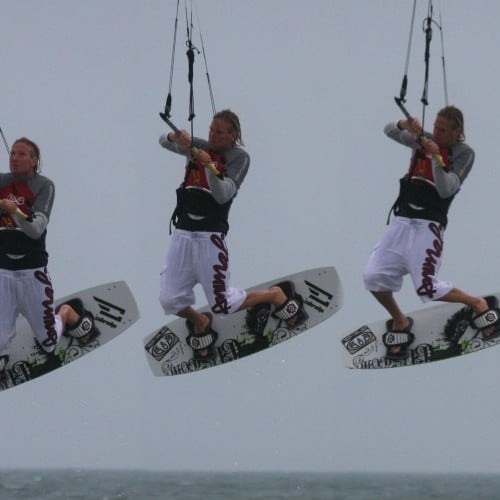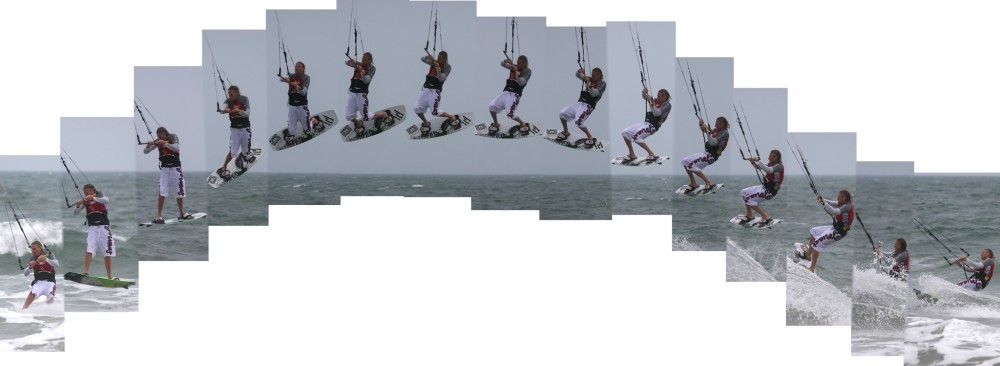
Kite Loop
Technique / Intermediate
Introduction
It’s often the way with kitesurfing that you can get focused on certain moves. Come rain or shine, you will not go in until you’ve stuck one. Sometimes this is a positive sign, a gentleman’s handshake with your learning curve, but sometimes it’s quite the opposite. Take for example your latest powered pop move, maybe a Raley to blind. It worked so well that last sunny session, when you had just enough power on your 12m, and the tide allowed you to kite in the butter of a lagoon. Today however, it was the epitome of frustration, you were hanging onto your 9m, the wind may have been gusting up and down 15 knots and it was as choppy as an Artex ceiling.
It’s all to easy to try and ignore our environment, but whether you be learning a new move, free-riding, or competing in a heat, you’ve got to be reasonable and give yourself a chance. Take the PKRA in Tarifa this year, a veritable loop-fest, fizzing with more testosterone than an Olympic power lifter’s “vitamins”. No doubt those loonies enjoyed it, and by Jove, the spectators did too. The conditions dictated what was possible, or not possible. It can be too windy, too choppy, so find a way to enjoy yourself and impress your friends/judges. You can have a ball, busting huge airs and scaring yourself silly, and to the outside world of non-kiters it’ll look the shizzle.
What is a Kite Loop?
In a nutshell a kite loop is when the kite loops backwards, as a result of the rider pulling on the back hand, which turns the kite. By continually pulling on the back of the bar, the kite will turn a full circle. This action is potentially potent because the kite will turn away from the direction of travel, therefore pulling against the forward force of momentum. Voluntary whiplash, quite wonderful! Kite loops are not to be confused with under-turns or down loops, which are performed by sending the kite forwards with the front hand. Here we will be taking you through the hooked in version.
Your Board Needs
Assuming that you can jump, your main prerequisite for a kiteloop is the ability to land well. If you are used to landing at speed (because you give the kite a good dive on the way down), and you are proud of your in flight board manoeuvring skills, always having it pointing downwind at the moment of reception, the prospects look good. During a kiteloop the kite generates extra power and will pull you off downwind. The combination of extra speed and the downwind pull means that landing on an edge is not an option, neither for you nor your beloved board.
Get Your Head in the Game
With a confident landing, the kite looping part should be child’s play. As always your aim here is to learn how to learn a move, so be reasonable and agree to ease yourself into the addiction of kite loops. Done the right way, in the right conditions there is nothing to fret about. If you’ve learnt under-turns you’ll be confident of your kites turning capabilities, knowing that as long as you keep pulling the kite just keeps turning.
12 O’clock Rock
Whether its midday or midnight, 12 o’clock is the perfect time to kiteloop. What we’re talking about here is, understanding where the power comes from during a kite loop, and how you can use this knowledge to your advantage. Yet again from your learning experience with under-turns you will know that for best results you always steered your kite up to the haven of 12 before giving the bar a tug. This way the kite turned without creating too much power, and it gave you loads of room to steer the kite around. The same should be true in the early days of kite looping.
When you stick your kite straight above you like this, and pull very hard on one side of the bar, your kite will turn/loop very quickly in a tight radius above you, relatively near to the edge of the window. Your kite reacts quickly from here because you are hanging underneath it, which in turn keeps the tension in the lines and makes the kite responsive. An additional plus point is that the kite is flying way above you, which means you’d have to do something unbelievably unfortunate to get it down low, with you up high. This is a good thing! If you were to start your loop with the kite at either 10 o’clock or 1 o’clock, even if the kite turns quickly, it will be lower and therefore deeper into the power, giving you more of a yank. So to a degree, from where you start the kiteloop will determine how much va va vroom you get.
Kites
Not wanting to start some forum war, but pretty much all modern kites will turn on a sixpence, whether bow, hybrid or C. The “I’m a man because I kiteloop a C kite” argument died a death the day the designers made them turn, and that’s a fair few years ago now. A full, cohones to the wall kite loop can be done on any kite and is really up to the mentalist helming the thing. We’ve already mentioned the starting point, so you know that for “man points” (excuse the expression ladies), you’ll leave the kite behind you and then pull. However the other contributing factor, ignoring wind speed is how hard you pull on your bar. The harder you pull, the smaller the looping radius and therefore the less power you’ll get. If you gently steer the kite around in a huge mother of a loop, you can expect to get some serious kick, and then you’ll still need enough height to get it all the way around…. Something for you to practice further down the line perhaps? To aid yourself in this fast moving business you must keep the kite sheeted in so that it keeps on turning, very important on bows. Try moving the back hand down the bar to get some extra leverage and when you do pull, push with your front hand to guarantee a reaction.
Timing & Balance
Whilst learning to kiteloop you’re best to leave the big pull until you feel yourself descending. This way you’ll have less forward momentum, less power in the kite and more chance of controlling it. You also need to anticipate from where the pull will come in order to keep well balanced when it does. Although you may expect the pull to come from downwind of you, because the kite is being steered back it will pull you back as well. If you are trying to spot your landing, looking forwards as the kite pulls back you could well get out of shape. As a rough guideline once you pull, turn you head slightly so that you nose is pointing towards you back hand. Once the power has gone you can worry about where you’ll be landing.
L-Plates
Now that you’ve perused through the scripture just remember:
- You’ll want just enough power to get you of the water for a gentle jump, 1 metre would be adequate height.
- Its advisable to redirect the kite after take-off so that it’s flying at 12 o’clock. From here you can loop it with less power.
- Pull as hard as you can with your back hand, and remember that you shouldn’t stop pulling until your kite is rising, having turned 360°.
- Move your back hand down the bar for more leverage, and use both hands to steer, the back one pulling, the front one pushing
- You want to turn the kite in as tight an arc as possible. To do this successfully you’ll need to keep the bar on the sweet spot and not sheet out.
- Anticipate the pull by looking slightly back over your back hand.
- Land with the board facing downwind.
Bona Fide
If you follow the sequence and video 1.
- Pic 1. Christian approaches as for a jump. He’s had a good look around to check for space and he moves the kite to around 1 o’clock ready for the off.
- Pic 2. Christian now sends the kite back and carves hard into the wind.
- Pics 3 & 4. As Christian rises up he lifts his knees for balance, keeps the bar in and steers the kite forwards in an effort to get it back above him.
- Pics 5 & 6. Now with the kite flying happily above him Christian starts to pull aggressively on his back hand.
- Pic 7. You can see Christian has his back elbow pulled right into his side and his front arm is pushing the other side of the bar away to help the kite turn as quickly as possible.
- Pics 8, 9 & 10. As the kite starts to pull from Christian’s left side, he holds the bar in and continues to steer the kite. His legs get left momentarily behind as his body gets pulled downwind and to his left.
- Pic 11. Christian has a sneaky peek to check that the kite is completing its loop. He is still pulling hard on the back hand!
- Pic 12. As the kite rises back up Christian stops pulling and concentrates on where he might land.
- Pic 13. Dropping gently towards the water as the kite rises back up towards 12 o’clock, he turns his board downwind and extends his legs ready for impact. You can see how he is almost staring at his chosen landing strip.
- Pic 14. In this kite loop Christian has realised that the kite will go all the way back up, which would leave him with no power for landing. To compensate for this he now dives the kite with his front hand, to pull himself out of the jump with a bit more speed.
- Pic 15. Christian absorbs the landing with his knees. The entire time he’s been concentrating on what’s ahead and has trusted his kite (a rather nice Convert 12m). Now he can carve out, smile and untwist his lines by spinning his bar.
Top Tips
It’s quite acceptable when you learn, to land before the kite has looped. As long as it is has turned enough to be moving forwards you’ll be fine. After that jump a bit higher and start pulling earlier.
Whatever you do, the golden rule of kite looping is keep pulling. It’s all too easy too doubt when you see the kite diving, but as long as the kite keeps turning, you’ll be sure of a happy ending.
This technique article was in Issue 6 of IKSURFMAG.
Related
By Christian and Karine
Christian and Karine have been working together as a coaching team, running improver to advanced kitesurfing clinics since 2003.




















